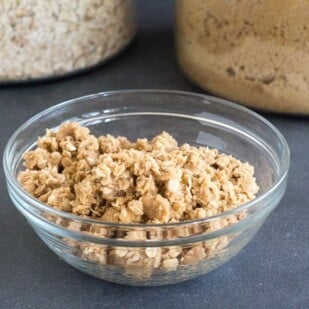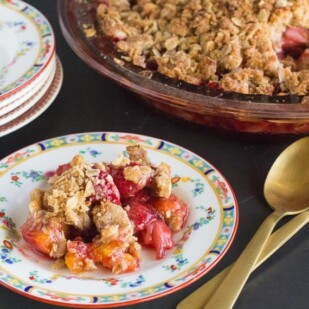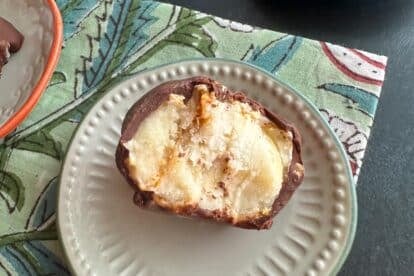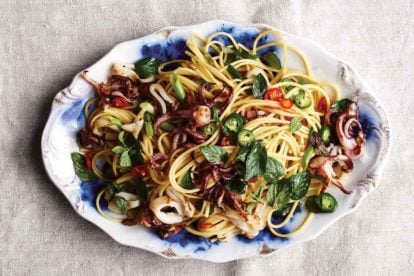Our Low FODMAP Tropical Crisp combines pineapple, coconut, papaya, banana, lime, vanilla and chocolate – all in low FODMAP amounts; all native to tropical climes. This is a crisp to rival the classic apple version. Easy to make and unlike any dessert you have ever had. Not much to look at, but I promise, the flavor and texture experience delivers!
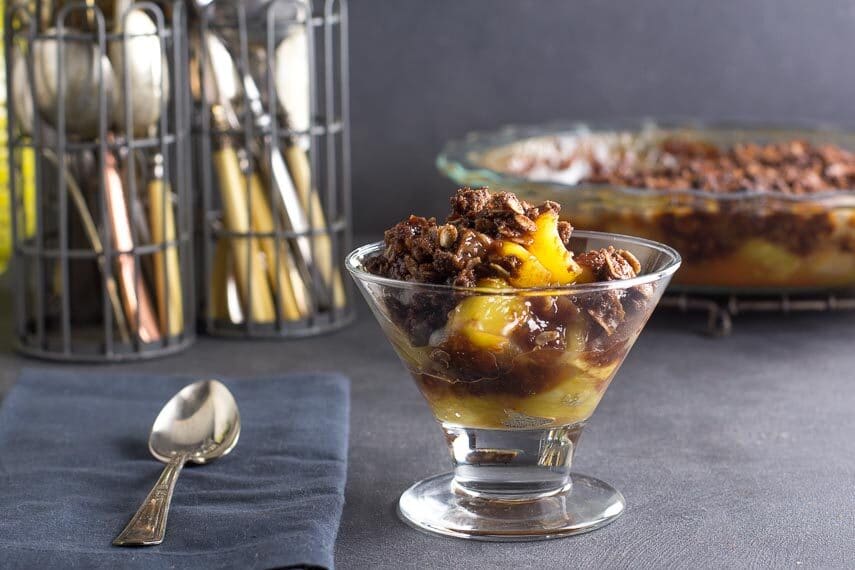
Which Fruit Are Low FODMAP?
This Tropical Crisp is a very fruit-forward dessert, so let’s dig into the fruits, one by one, and talk about their FODMAP content.
Bananas – Ah, bananas. This might be the most misunderstood fruit from a FODMAP perspective. Are they high FODMAP? They are on many high FODMAP lists…how can it be that there are low FODMAP banana recipes? We cover all of this, in-depth, in our article Are Bananas Low FODMAP? The short answer is that it all comes down to portion. You can have ripe banana in 35 g portions (about one-third a medium banana), Our recipes always take this into consideration.
Cocoa – In this recipe the chocolate flavor is provided by cocoa, and in this case natural cocoa. I have a lot to say about cocoa.
If you ever use cocoa powder, please do yourself a favor and read All About Cocoa & FODMAPs. There are some discrepancies on the Monash app that I discuss in that article.
And yes, cocoa pods are a fruit, so it is part of this list.
Coconut – Coconut comes in many forms from water to milk to oil, cream to fresh, and a variety of dried. Please read Is Coconut Low FODMAP? for more info. In this recipe for Tropical Crisp I call for unsweetened broad flakes of coconut, sometimes called chips. They add coconut flavor, texture and a great visual. Again, the amount of coconut per serving is low FODMAP. I also use coconut oil to boost the coconut flavor. As a fat, it is naturally low FODMAP. Use unrefined coconut oil to get the coconut flavor. Refined coconut oil is to neutral for this dish.
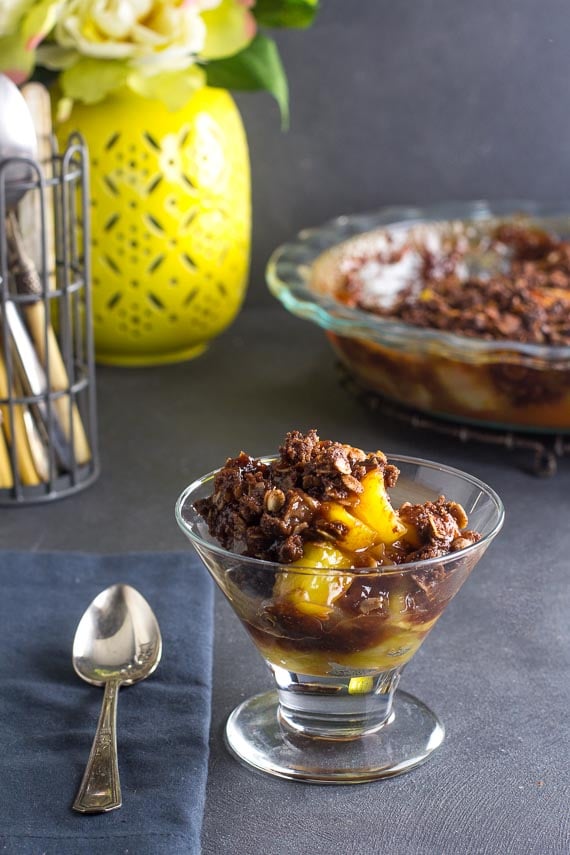
Lime – For this Tropical Crisp I add fresh lime juice and zest to the crisp filling and it adds a zingy, acidic flavor that brings all of the fruit flavors together.
Papaya – Monash University has lab tested ripe papaya and it contains no FODMAPs. This makes it a fantastic fruit to work with in the low FODMAP kitchen. (Check out our Papaya Salsa, where it is featured in style).
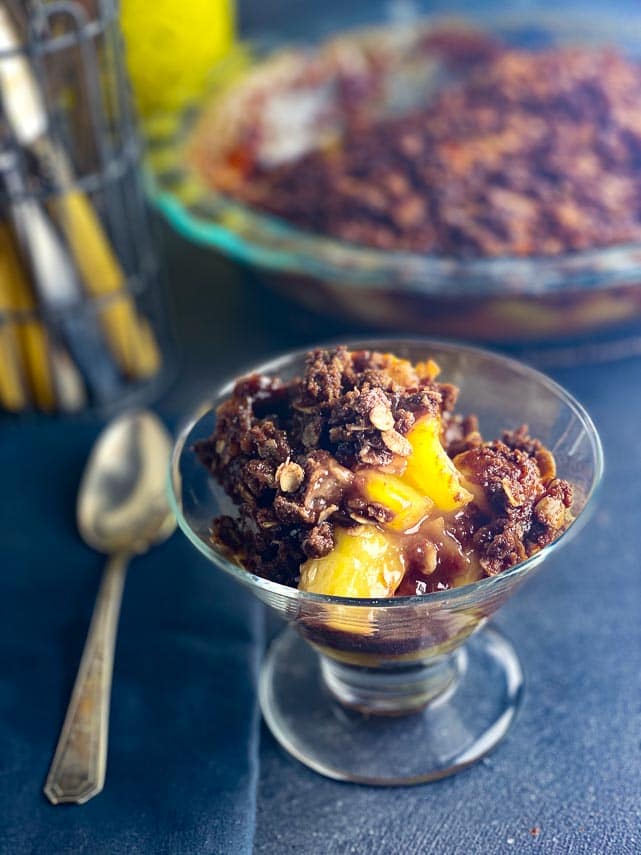
Pineapple – Monash and FODMAP Friendly have both lab tested fresh pineapple. Monash lab tests deem 1 cup fresh, chopped pineapple at 140 g to be Green Light low FODMAP. FODMAP Friendly give it a “Pass” at 1 cup (150 g). Monash has also tested dried pineapple and they have not determined a low FODMAP amount. It is Moderate at 25 g for fructans.
Vanilla – Vanilla is the only edible fruit of the orchid family, the largest family of flowering plants in the world. We like pure vanilla extract and call for it in this Tropical Crisp topping.
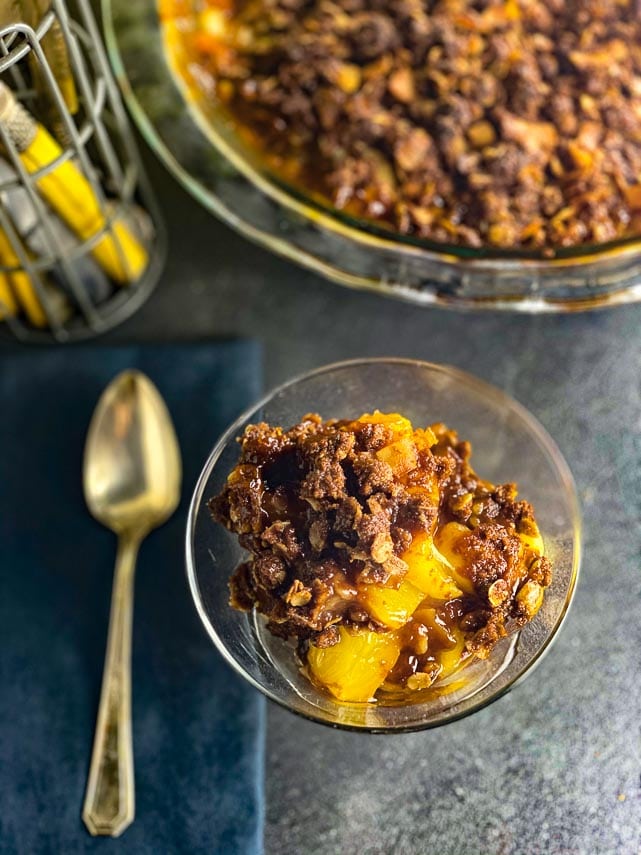
Looks Can Be Deceiving
I actually have never seen an ugly duckling, I find them all adorable, but you know the term. This Tropical Crisp is a bit homely – the food equivalent of an ugly duckling. I have tried my best to show you in images that it is enticing. I implore you to give it a try. You will not be disappointed.
The first time I made this was as part of an array of 17 desserts for a massive party, and this was the only dessert that was finished, the baking dish scraped clean. Score one for the “plain Jane’s” of the food world. Expect an unassuming look, but with a huge payoff in flavor and texture. And to the “Jane’s” reading this, we know you are anything but plain.
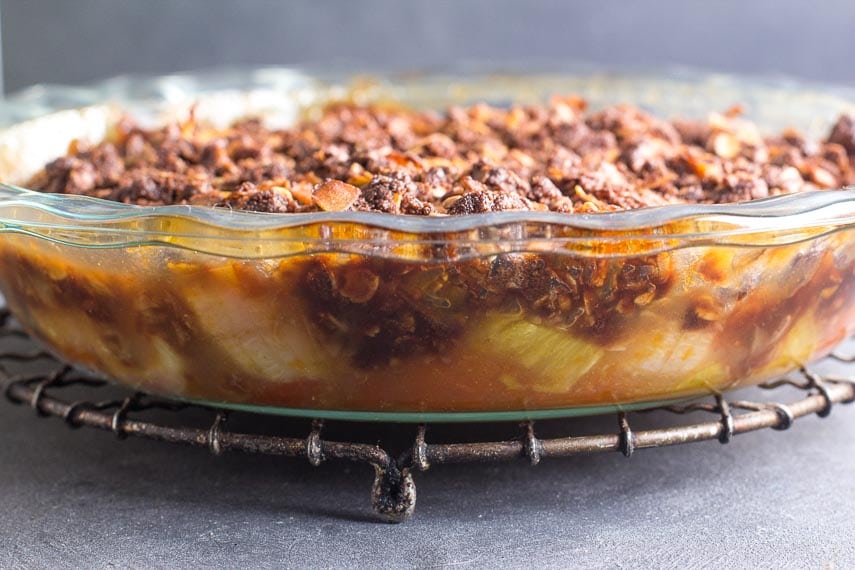
What Can I Make Ahead?
The topping, like all of our crisp toppings, can be made 1 month ahead and frozen. Make a double batch and freeze half for later in a zip-top bag. Simply defrost as oven preheats.
A Spirited Variation
My original version was conventional and not low FODMAP and it called for ¼ cup (60 ml) gold rum in the filling. Rum has been lab tested and unfortunately it is high for fructose. What does this mean?
Well, if you digest fructose well, you could add it in. It is a fabulous addition. Just stir into the fruit filling.
And speaking of fructose, again, if you digest it well, you can add mango to this recipe instead of the papaya or as part. Know your own tolerances. Just FYI: Monash has determined that a Green Light low FODMAP serving size of fresh mango is 40 g, or ⅕ cup, cubed.
Ingredients For Low FODMAP Tropical Crisp
This crisp has two components: the crisp topping and then the fruit filling.
Let’s look at the topping first. Easy to find ingredients – and easy to mix together in one bowl.
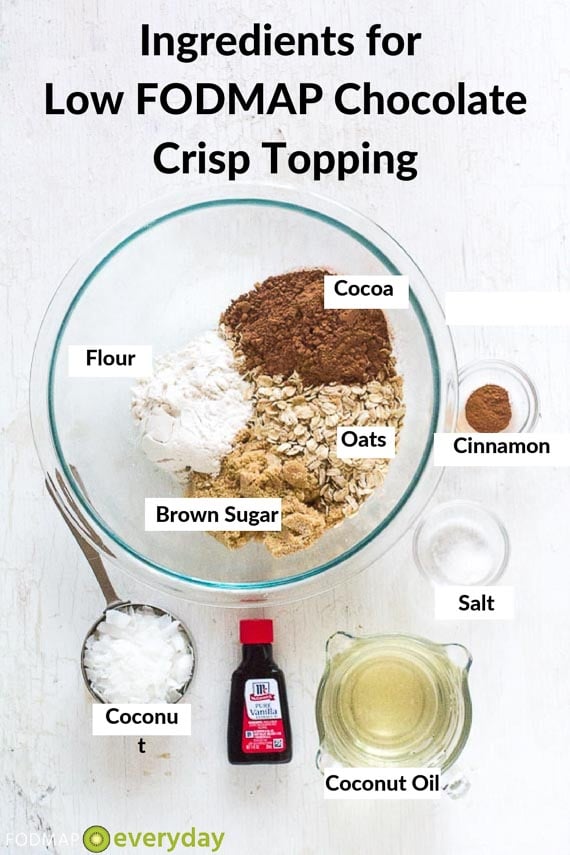
The filling is as juicy and delicious as it looks. Make sure to use fresh lime juice; you need the zest anyway, so buy a nice, heavy-for-its-size lime.
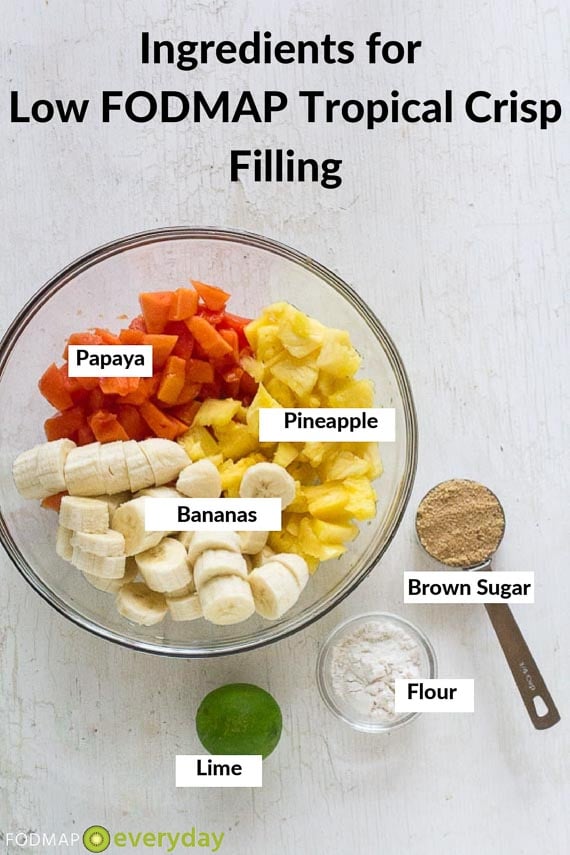
How To Make Low FODMAP Tropical Crisp
Make the Topping
Position a rack in the middle of the oven. Preheat the oven to 375°F (190°C). Coat a 9 ½-inch by 1 ½-inch (24 cm by 4 cm) deep-dish pie plate, or decorative ovenproof dish, with nonstick spray. Place the dish on top of a parchment- lined rimmed baking pan (to catch drips).
In a medium sized mixing bowl, stir together the brown sugar, oats, flour, cocoa, cinnamon, and salt.
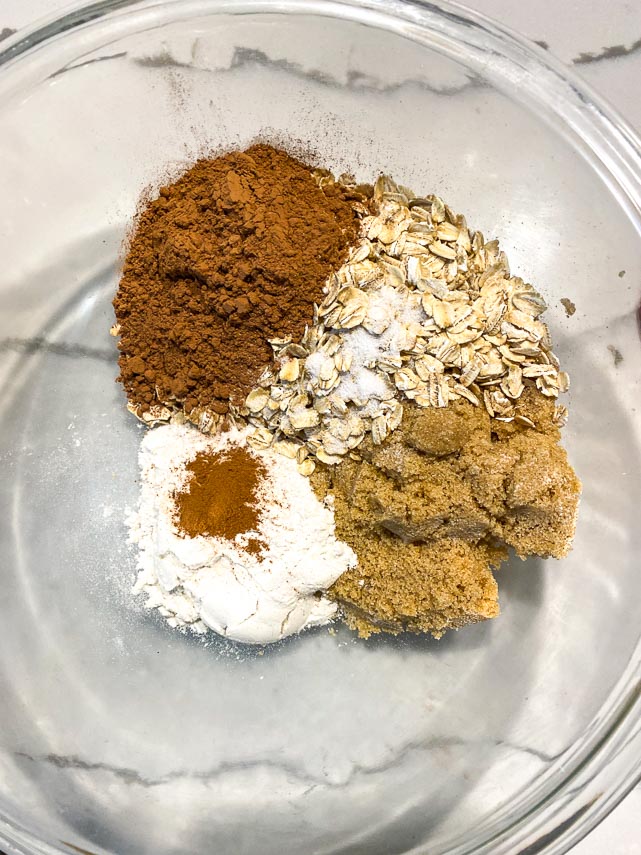
Stir in melted coconut oil…
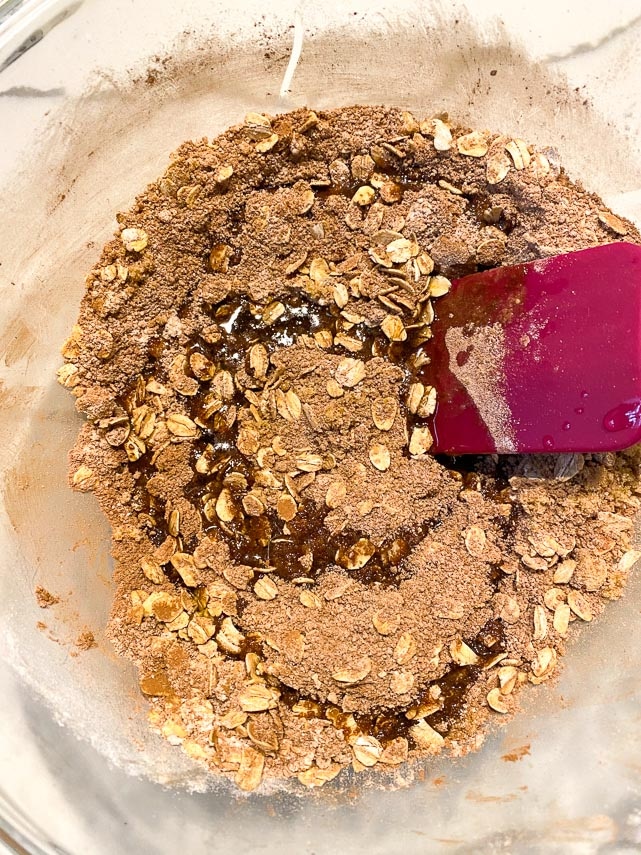
…until it looks like this…
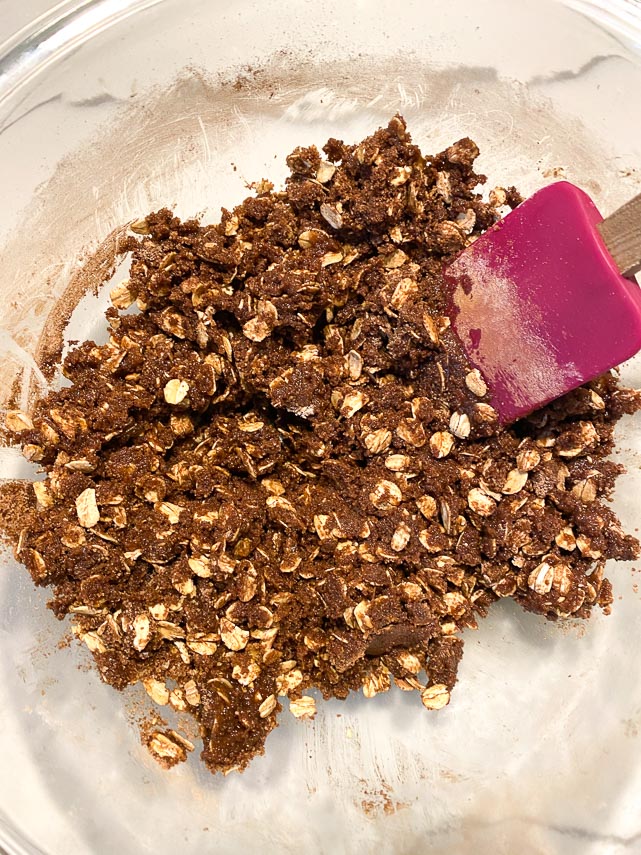
Then gently fold in the coconut flakes.
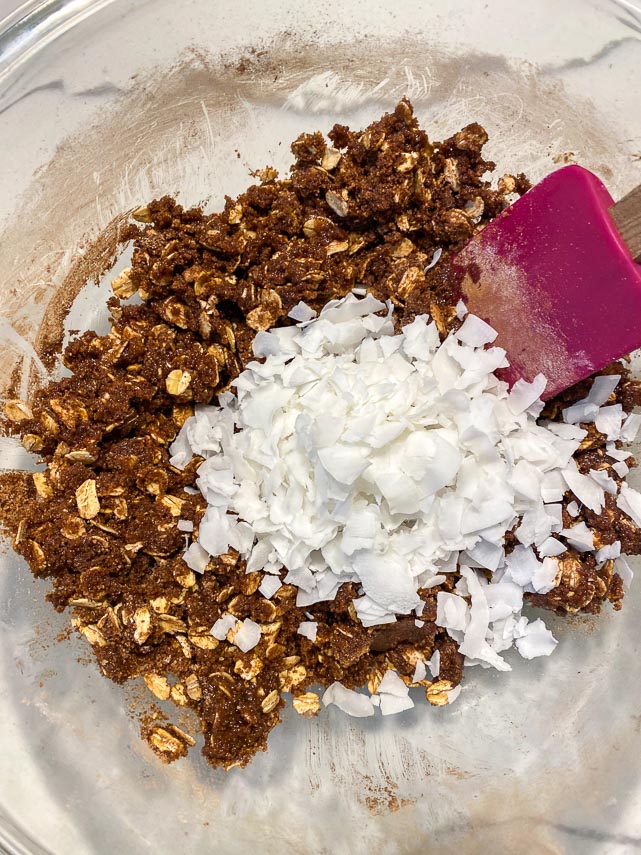
You do want it to be clumpy, not loose. Squeeze the clumps together with your fingers, if necessary.
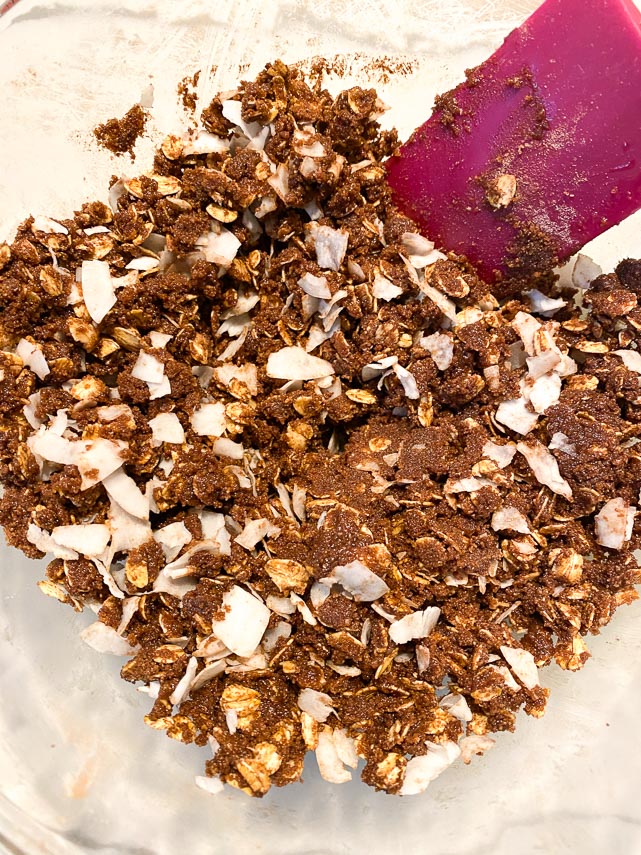
The topping may be frozen in a zipper- top bag for up to 1 month ahead; just defrost as the oven pre-heats.
Make the Filling
Fold all of the filling ingredients together in a medium sized mixing bowl.
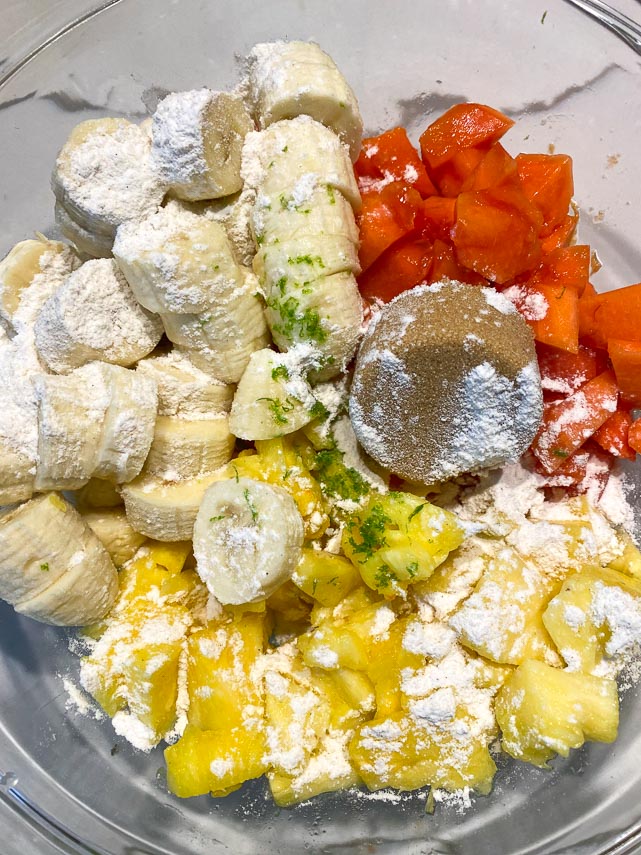
Scrape into the prepared baking dish.
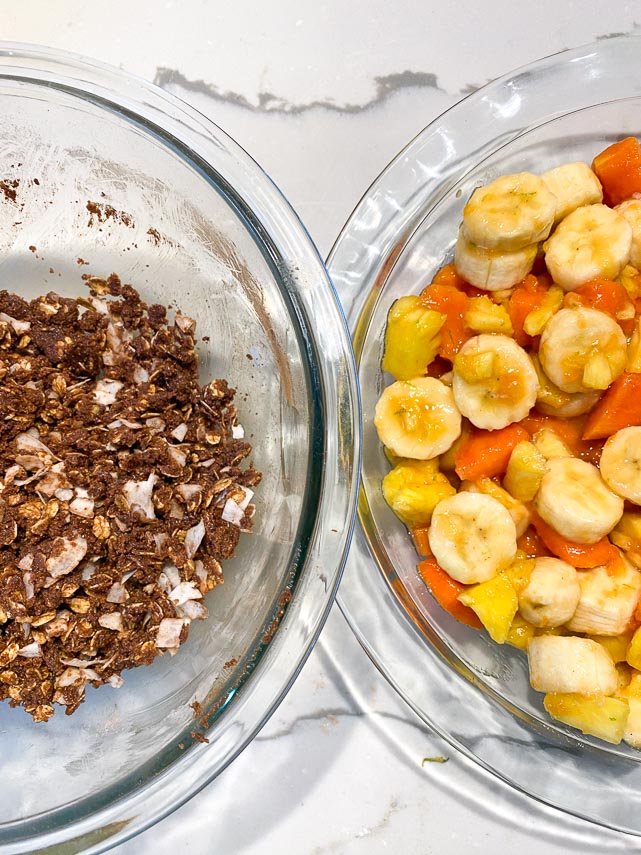
Scatter the topping evenly over the fruit.
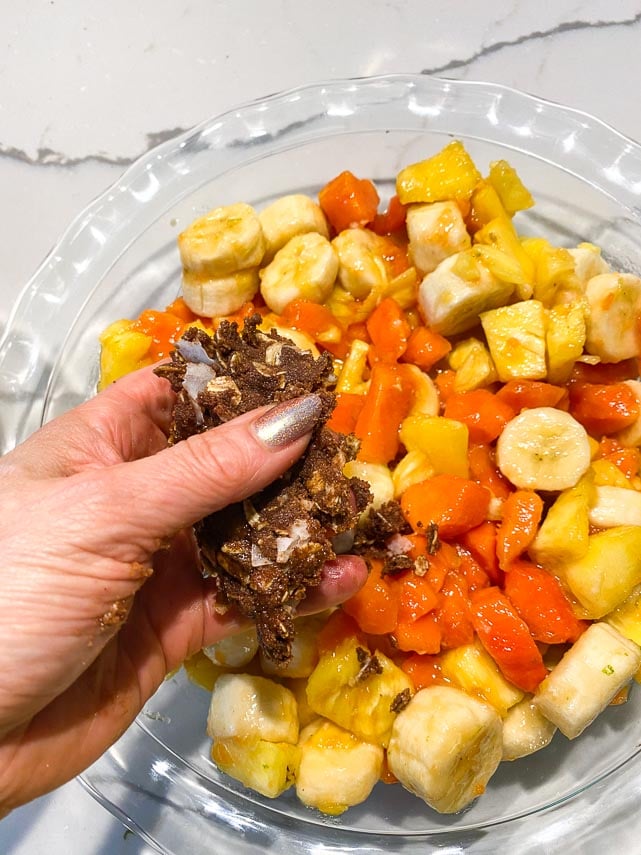
Here it is ready for the oven!
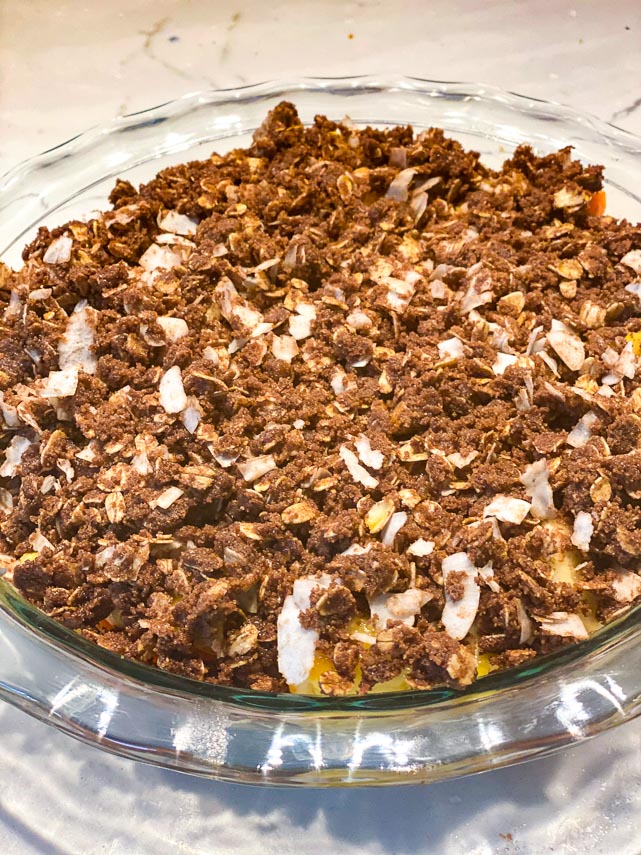
Bake for 35 to 45 minutes or until the topping is crisp and the fruit is bubbling around the edges.
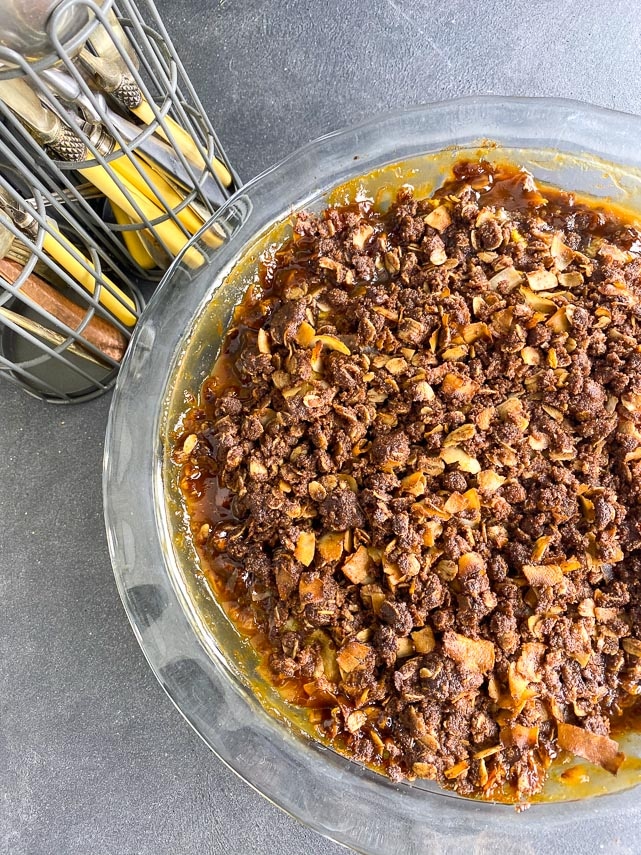
It is dark because of the cocoa, so it is a bit more difficult to tell when it is lightly “browned”. Let sit for 10 minutes before serving. It may be served warm or at room temperature but is best eaten the day it is made when the topping will be its most crunchy. DIG IN!
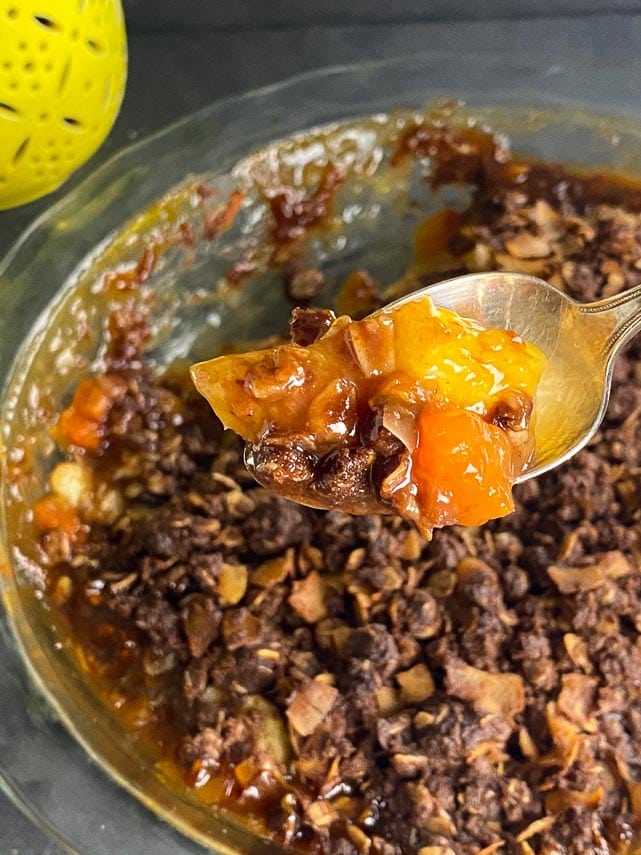
Can I Have My Crisp A La Mode?
Who doesn’t like warm fruit crisp with vanilla ice cream melting into it – are you drooling along with me? Problem solved! Just use any lactose-free vanilla ice cream (that is also low FODMAP, of course). Our No-Churn is a DIY option.
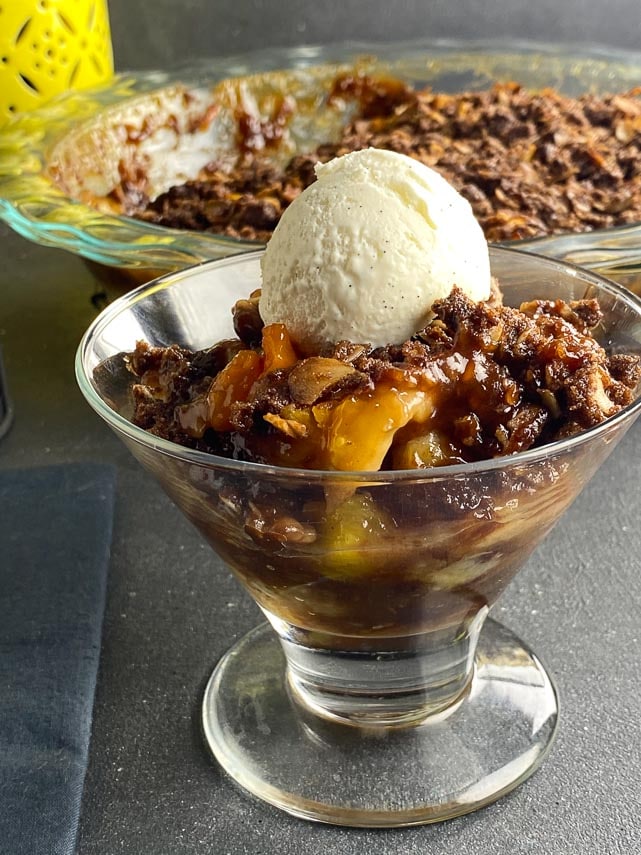
More Crisps For You
- Grape & Apple Crisp
- Strawberry Rhubarb Crisp
- Strawberry Peach Coconut Crisp
- Cranberry Crisp with Grapes & Citrus
- Vegan Crisp Topping
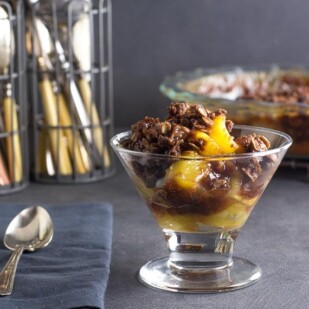
Low FODMAP Tropical Crisp
Our Low FODMAP Tropical Crisp combines pineapple, coconut, papaya, banana, lime, vanilla and chocolate – all in low FODMAP amounts; all native to tropical climes. This is a crisp to rival the classic apple version. Easy to make and unlike any dessert you have ever had. Not much to look at, but I promise, the flavor and texture experience delivers!
Ingredients:
Topping:
- ¾ cup (160 g) firmly packed light brown sugar
- ⅔ cup (65 g) old-fashioned rolled oats (not quick or instant oats)
- ⅓ cup (49 g) low FODMAP, gluten-free all-purpose flour, such as Bob’s Red Mill 1 to 1 Gluten Free Baking Flour
- 3 tablespoons sifted natural cocoa
- ¼ teaspoon cinnamon
- ¼ teaspoon salt
- 6 tablespoons (90 ml) melted unrefined coconut oil
- ½ cup (20 g) unsweetened broad coconut flakes/chips
Filling:
- 3 medium-sized ripe bananas, cut into ½-inch (12 mm) chunks
- 3 cups (420 g) papaya chunks (½-inch/12 mm pieces)
- 2 cups (280 g) fresh pineapple chunks (½-inch/12 mm pieces)
- ¼ cup (54 g) firmly packed light brown sugar
- 1 tablespoon low FODMAP gluten-free all-purpose flour, such as Bob’s Red Mill 1 to 1 Gluten Free Baking Flour
- 2 teaspoons freshly squeezed lime juice and zest of 1 lime
Preparation:
-
For the Topping: Position a rack in the middle of the oven. Preheat the oven to 375°F (190°C). Coat a 9 ½-inch by 1 ½-inch (24 cm by 4 cm) deep-dish pie plate, or decorative ovenproof dish, with nonstick spray. Place the dish on top of a parchment- lined rimmed baking pan (to catch drips).
-
In a medium sized mixing bowl, stir together the brown sugar, oats, flour, cocoa, cinnamon, and salt. Stir in melted coconut oil, then gently fold in the coconut flakes. You do want it to be clumpy, not loose. Squeeze the clumps together with your fingers, if necessary. The topping may be frozen in a zipper- top bag for up to 1 month ahead; just defrost as the oven pre-heats.
-
For the Filling: Fold all of the filling ingredients together in a medium sized mixing bowl. Scrape into the prepared baking dish. Scatter the topping evenly over the fruit.
-
Bake for 35 to 45 minutes or until the topping is crisp and the fruit is bubbling around the edges. It is dark because of the cocoa, so it is a bit more difficult to tell when it is lightly “browned”. Let sit for 10 minutes before serving. It may be served warm or at room temperature but is best eaten the day it is made when the topping will be its most crunchy.
Notes:
Tips
FODMAP Information
Our recipes are based on Monash University and FODMAP Friendly science.
- Bananas: Bananas have both low and high FODMAP serving sizes. For the common banana, Monash University lab tests report that 1 medium unripe banana of 100 g is low FODMAP, and that ⅓ of a medium ripe banana at 35 g is low FODMAP. Note that most baking recipes use very ripe bananas; our serving sizes reflect low FODMAP portions.
- Cocoa: Monash University has lab tested what they call “cocoa” and also “cacao” and they show different FODMAP content. The problem is that from the chocolate manufacturing industry’s perspective, there is no difference between cacao and cocoa powder. The FDA, The Food Standards for Australia and New Zealand, the ICCO (International Cocoa Organization) and the National Confectioners Association do not even recognize the term “cacao” to describe cocoa powder. We have an article, All About Cocoa, that we encourage you to read. It attempts to explain the discrepancies in the Monash lab testing.
- Dried Coconut: Dried coconut has been lab tested by both FODMAP Friendly and Monash University. Monash states has established that the low FODMAP amount is ½ cup (30 g). FODMAP Friendly gives it a “Pass” at 4 tablespoons or 25 g.
- Lime Juice: Monash University has lab tested lime juice and it is low FODMAP in 1 cup (250 g) amounts (double that of lemon juice, as an interesting fact).
- Oats: Both Monash and FODMAP Friendly have both lab tested oats. FODMAP Friendly gives rolled oats a “Pass” at ½ cup or 43 g servings. Monash has several app entries and some are country specific. Here we present their “basic” app entries which are not country specific (use your app to look up the other entries). For their main entry called “rolled oats” they say a Green Light low FODMAP serving is ½ cup, which they peg at 52 g. For “quick oats” they state that a low FODMAP serving is only ¼ cup at 23 g, becoming moderate Yellow Light at ½ cup or 47 g.
- Oil: All pure oils are fats and contain no carbohydrates, therefore they contain no FODMAPs.
- Papaya: Monash University has lab tested ripe papaya and it contains no FODMAPs. Dried papaya (paw paw) is low FODMAP in 5 g servings.
- Pineapple: Monash and FODMAP Friendly have both lab tested pineapple. Monash lab tests deem 1 cup fresh, chopped pineapple at 140 g to be Green Light low FODMAP. FODMAP Friendly give it a “Pass” at 1 cup (150 g). Monash has also tested dried pineapple and they have not determined a low FODMAP amount. It is Moderate at 25 g for fructans.
- Sugar: Monash University and FODMAP Friendly have both lab tested white, granulated sugar. Monash states that a Green Light low FODMAP serving size of white sugar is ¼ cup (50 g). FODMAP Friendly simply states that they have tested 1 tablespoon and that it is low FODMAP. Regular granulated white sugar is sucrose, which is a disaccharide made up of equal parts glucose and fructose. Sucrose is broken down and absorbed efficiently in the small intestine.
Please always refer to the Monash University & FODMAP Friendly smartphone apps for the most up-to-date lab tested information. As always, your tolerance is what counts; please eat accordingly. The ultimate goal of the low FODMAP diet is to eat as broadly as possible, without triggering symptoms, for the healthiest microbiome.
Nutrition
All nutritional information is based on third-party calculations and should be considered estimates. Actual nutritional content will vary with brands used, measuring methods, portion sizes and more. For a more detailed explanation, please read our article Understanding The Nutrition Panel Within Our Recipes.
